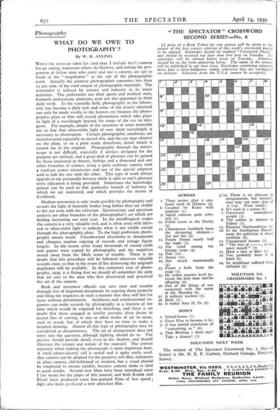Photography
WHAT DO WE OWE TO PHOTOGRAPHY ?
By W. R. AYLING WHEN the amateur takes his (and may I include her?) camera for an outing, numerous others do likewise, and noting the pro-
portion of fellow men who carry and use a camera, are apt to think of the " snapshotter " as the salt of the photographic earth. Actually the amateur photographer consumes less than 55 per cent. of the total output of photographic materials. The remainder is utilised by science and industry in its many activities. The professions use their quota and medical men, formerly enthusiastic amateurs, now use the apparatus in their daily work. In the scientific field, photography in the labora- tory has become a daily task and some of the results obtained can only be made visible to the human eye because the photo- graphic plate or film will record phenomena which take place in light of a wavelength beyond the range of the eye to inte- grate. For example, details of the structure of some materials are so fine that ultra-violet light of very short wavelength is necessary to observation. Certain photographic emulsions are manufactured especially to record this, and the eye may observe on the plate, or on a print made therefrom, detail which it cannot see in the original. Photography through the micro- scope is not difficult, especially if devices designed for the purpose are utilised, and a great deal of pleasure can be gained by those interested in botany, biology and a thousand and one other branches of science, using a quite ordinary camera with a medium power microscope and one of the special adaptors sold to link the one with the other. This type of work always appeals to me personally because while it adds to one's pleasure extra education is being provided. Sometimes the knowledge gained can be used in that particular branch of industry in which we are interested, and which provides the means of livelihood.
Modern astronomy is only made possible by photography and reveals the light of heavenly bodies long before they are visible to the eye even with the telescope. Spectroscopy and spectrum analysis are other branches of the photographer's art which are finding increasing use each year. In the metallurgical trades the camera is a very valuable tool, and is often used with infra- red or ultra-violet light to indicate what is not visible except through the photographic plate. To the legal profession photo- graphy means much. Unauthorised alterations to documents and cheques, routine copying of records and storage figure largely. In the recent crisis many thousands of record cards and papers were copied by photography and the negatives stored away from the likely scene of trouble. There is no doubt that this procedure will be followed wherever valuable records exist, so that in the event of fire destroying the originals duplicates will be available. In this centenary year of photo- graphy, 1939, it is fitting that we should all remember the debt that we owe to the men who first discovered and practised the art of the camera.
Bank and insurance officials can save time and trouble through loss of important documents by copying them properly and filing the negatives in such a manner that they will last for years without deterioration. Architects and constructional en- gineers can make records by photography in a fraction of the time which would be required for sketching, and there is no doubt that those engaged in similar pursuits often desire to record bits of carving in situ or other works of art in stone, steel or wood, but of which they have no time to make a detailed drawing. Almost all this type of photography may be considered as documentary. The art of arrangement does not enter into the question, although lighting should do so. The
picture should provide detail, even in the shadow, and should illustrate the texture and nature of the material. The correct
exposure when making the photograph is most important here.
A small photo-electric cell is useful and is quite easily used. Any camera can be adapted for the purpose, roll film, miniature or plate camera, old-fashioned or modern, but a stand should be employed to ensure rigidity, because camera shake is fatal to good results. Several new films have been introducd since I last wrote for the pages of this journal, and both Kodak and Ilford have produced extra fine-grained films of fast speed ; Agfa also have prcduced a new ultra-fast film.






































 Previous page
Previous page